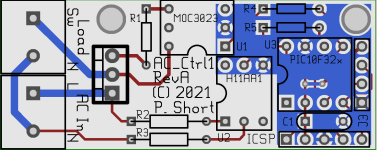Probably a pointless exercise, but here is a view of a one-channel dimming AC controller that I'm working while at my ex's place 2000 miles from home.
Somewhat inspired by Dirk's OneSticks, it's 0.8" x 2" in size and is a dimming controller combined with an AC SSR. The controller incorporates a dimming curve table from the get-go capable of controlling the on-timing down to about the 4uS resolution (about 8x better than Renard). It has 128 levels of brightness input, received as a single character at 115200 baud, although there are provisions for daisy-chaining several controllers together. For the potential daisy-chain mode it would use a very simple protocol, using just a '0x00' byte as the frame delimiter and allow data byte values of 1-127. The 4-pin connector on the right side of the PCB is for providing data and power to the controller.
I don't know if this is going to go anywhere, considering the rapidly declining interest these days in AC controllers, so maybe this is just something to entertain myself while away from home.
Somewhat inspired by Dirk's OneSticks, it's 0.8" x 2" in size and is a dimming controller combined with an AC SSR. The controller incorporates a dimming curve table from the get-go capable of controlling the on-timing down to about the 4uS resolution (about 8x better than Renard). It has 128 levels of brightness input, received as a single character at 115200 baud, although there are provisions for daisy-chaining several controllers together. For the potential daisy-chain mode it would use a very simple protocol, using just a '0x00' byte as the frame delimiter and allow data byte values of 1-127. The 4-pin connector on the right side of the PCB is for providing data and power to the controller.
I don't know if this is going to go anywhere, considering the rapidly declining interest these days in AC controllers, so maybe this is just something to entertain myself while away from home.

